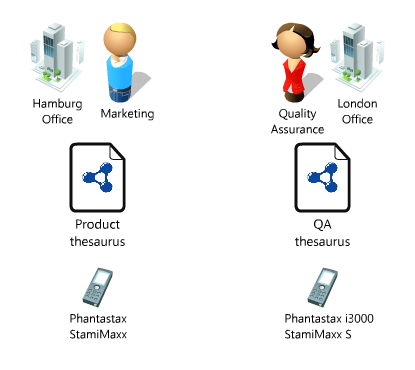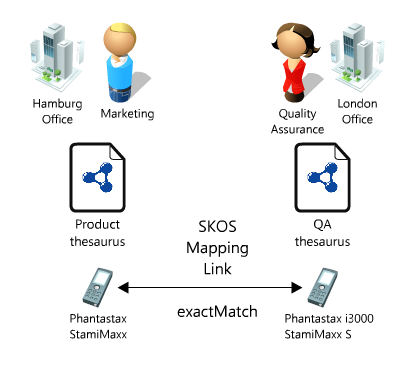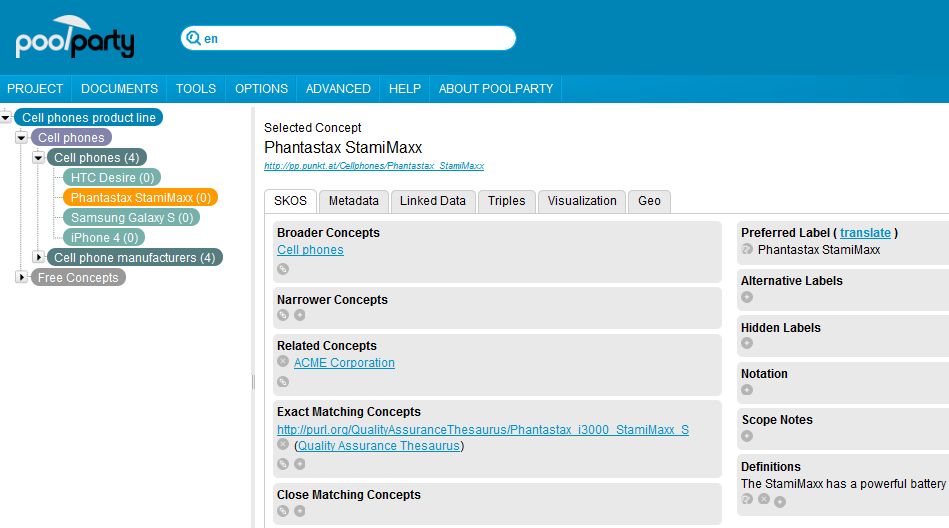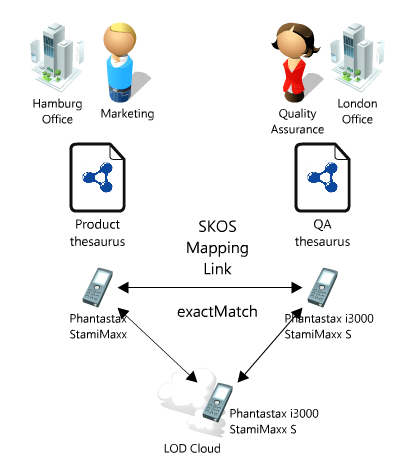Learn more
- Apr 8, 2011
Linked data based thesaurus management in collaborative settings
The creation and management of controlled vocabularies in companies often takes place in a distributed manner. Different departments in different branch offices often rather create their own vocabularies, than have one large central knowledge model, where everyone contributes.
How to model divergent views on one concept?
Such a central model is not only much harder to manage, but there is also the general problem that differerent departments like marketing, quality assurance, R&D, etc. will have divergent views on the model and its concepts. These different perspectives on one and the same concept are hard to unify in a single model.
Think of a company that sells mobile phones and wants to create a model of its line of products. It wants to utilize this model in the context of its online shop as well as in the context of its user support forum. While the structure of the model (i.e. the relationships between the products) might be very similar or the same in both contexts, there will be differences in which properties of the products are actually relevant in the respective contexts.
In the model of the marketing department there might be a concept for a “Phantastax StamiMaxx” cell phone with a definiton “The StamiMaxx has a powerful battery and is great for professionals who travel a lot”. They might relate it to manufacturer “ACME Corporation” and to several concepts representing different features like “Android OS”, “Multi-touch touchscreen”, etc.
The very same phone has different properties that are interesting from the Quality Assurance departement’s perspective. They might call it by a more specific name like “Phantastax i3000 StamiMaxx S”, have a different definition for it like “3G cell phone implementing the new WTF3000 protocol, …” and relate it to concepts representing known problems and their solutions.
Now they face the task to integrate these different models, as it is not desirable to use a bunch of isolated models within one company.
Support of collaborative work on distributed models
To support this kind of collaborative work on distributed knowledge models, we would like to link the concepts of the models, just as is we link documents in the World Wide Web. Fortunately the Simple Knowledge Organisation System (SKOS) offers mapping properties that can be used to define relationships between concepts from different knowledge models.
E.g. when we want to say that concept “Phantastax StamiMaxx” in the product line thesaurus refers to the same real world entity as concept “Phantastax i3000 StamiMaxx S” in the Quality Assurance thesaurus, then we can use skos:exactMatch to express that. If we want to express that the concepts are merly similar, skos:closeMatch could be used.
The other SKOS mapping properties express a hierarchical (narrowMatch, broadMatch) or an associative (relatedMatch) mapping relation between concepts from different concept schemes. With those we can say that my Samsung Galaxy concept has a skos:broadMatch “Smartphone” in the product line vocabulary and a skos:relatedMatch “ACME Corporation” in a controlled vocabulary about Tech companies.
Modularisation of knowledge models
In this way SKOS thesaurus management systems like PoolParty make it possible to modularise knowledge models, represent concepts in their different contexts and consequently enable collaborative work on those models: The marketing guy can work on his model with the concept properties focused on sales without disrupting the work of the quality assurance expert on her own thesaurus. Later one or both of them can create the skos:exactMatch link between the concepts that are the same, like seen in the “Exact Matching Concepts” box in screenshot of PoolParty below.
Enrich your knowledge: Get connected with the LOD Cloud
Going a step further the models could be connected to external knowledge, e.g. a source from the Linked Open Data (LOD) Cloud. Once we establish links to LOD hubs like DBpedia, we can import additional information for their concepts or use it to establish whether similar concepts from different models really refer to the same real world resource.



